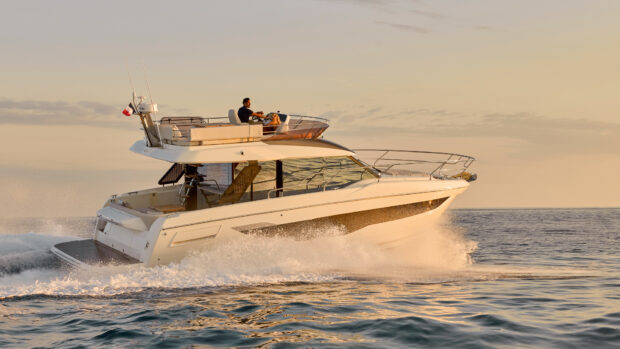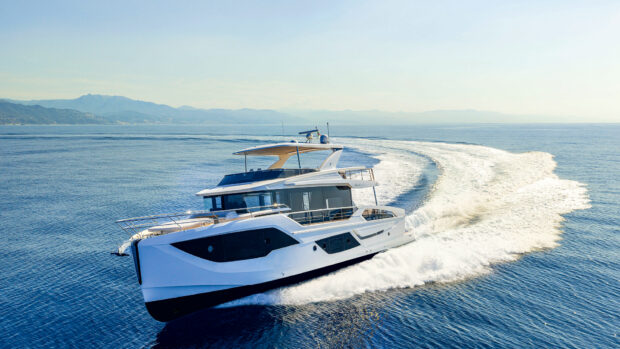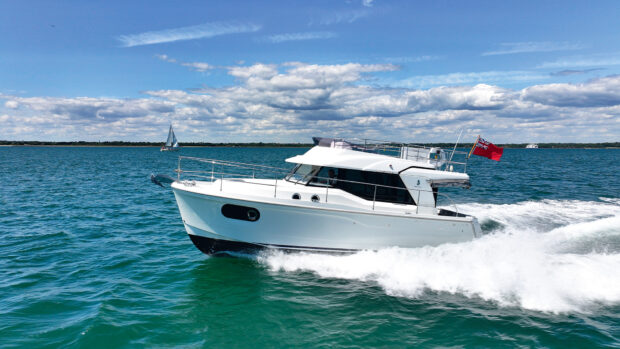The Sirena 68 won last year’s award for flybridges over 60ft. Can its new entry-level Sirena 48 repeat that success?
Trawler yachts are not generally seen as the go-to choice for young, boaters but Istanbul-based shipyard, Sirena Marine, sees things differently. Launched at the Cannes Yachting Festival in September 2023, its new entry-level Sirena 48 will inevitably court a younger demographic thanks to its relative accessibility in terms of scale, ease of use and affordability.
But according to Sirena COO, Ali Onger, the new Sirena 48 is also designed to offer an “unprecedented level of choice and flexibility” for a boat of its size, with both crewed and owner-operated versions on offer, as well as a variety of layouts for equal relevance in both America and the Med.
As you would expect though, the aesthetic overlap with the established 58, 68, 78 and 88 looks very strong. It shares the same Germán Frers semi-displacement hull form as the larger models and it looks very much part of the established family above the waterline too.
While trawler yachts always involve significant bulk, courtesy of voluminous hulls, lofty superstructures and full-beam flybridges, the design of the 48 subtly finesses the traditional formula with a raised foredeck, a plumb bow, elegant detailing in the hull sides and tinted glazing, both in the superstructure and in the squared-off hull windows.
It’s not a radical-looking boat by any means but there’s a slick, disciplined modernity to it that offsets the volume, making it feel much more appealing than most boats of its type.

As modern trawler yachts go, this is a really fine- looking example
Day spaces
The saloon on the new 48 is a modestly impressive place. The use of large vertical windows and a low-level dash makes everything feel remarkably bright and open and the fuss-free fit-out also helps with that. Pared back and linear furniture, trimmed neatly in pale woods, makes good use of the natural light, and headroom is also excellent for a flybridge-equipped boat of this size.
The layout is easy to get on with too. The two-man helm gets direct access to the starboard side deck through a big skipper’s door, and opposite that, a convertible C-shaped dinette benefits greatly from the raised level of the forward saloon and a big one-piece window on the portside that marries up exactly with the seating.
Given that the dinette is positioned aft of the skipper’s seat, it’s not the most sociable helm in the world but the flybridge arrangement certainly helps make up for that.

That huge flybridge provides ample shelter for the lower deck
Further aft, down a couple of steps, an L-shaped galley butts up against the back end of the dinette. It’s well proportioned, with an oven, a sink, a dishwasher and plenty of high-level storage. There’s also a sliding window directly above the four-ring electric hob, and the fact that the refrigeration is taken care of by the starboard cabinets means that with the three-part sliding door opened up, the galley integrates very well with the bench seating of the aft cockpit.
As for the cockpit itself, the test boat arrangement taps into the latest trends with facing settees, a central table and a glass balustrade. But there are options for the layout, not just in the cockpit but also on the aft platform, where you can go for a crew cabin or a storage zone with extra beach club style seating.
As you head forward, along the side decks, beneath the shelter of the big flared flybridge, a couple of steps take you up to the bow space. There’s loads of space up here but the arrangement is actually quite simplistic. It’s used for what looks like a three-man sunbed but it’s so long that you could feasibly scatter up to six people on it.

Although facing benches are all the rage, there are other options for the cockpit layout
There’s also a forward-facing three-man bench at the forward edge of the sunbed and yet there’s still enough room for a sensible, workmanlike forepeak, with beautifully integrated cleats and fairleads and a locker on either side of the anchor.
For our money, slightly more could be done to ramp up the flexibility of the foredeck, simply by shortening that enormous sun pad and using some facing seating to create an additional lunch space but even in this guise, it remains an extremely pleasant place to be.
The flybridge, however, is an even better example of its type. In contrast to the main deck, the helm is on the portside, which makes good sense in terms of simplifying your seamanship manoeuvres. It sits behind a huge lounging area that nestles in the lee of the wind deflector, complete with unbroken wraparound backrests.
There’s ample space for up to six people ahead of the skipper and there’s also a starboard bench with a reversible backrest that functions equally well as an inward-facing chaise longue. This means that if you need to make a bit of distance during a cruise, the driver of the 48 can easily be kept right at the heart of the party.

The foredeck is very large but arguably underutilised
Further aft, a transverse wet bar backs onto the skipper’s bench with a sink, an electric griddle and plenty of space for an optional fridge and ice maker. There’s also a huge central strut back here to help support the T-top.
That means Sirena has been able to limit any additional support to just four narrow stainless steel uprights around the periphery of the deck, so the views all-round are really impressive. And if you step aft again, Sirena has made great use of the beam by wrapping a big U-shaped seating section around the back end of the flybridge.
It comes with a pair of fold-out tables, so you can leave gaps for people to make their way in and out without having to slide sideways along the seats, or link them together to create one big table for up to eight diners.

he raised dinette marries up with a huge port window for great views
Cruising facilities
Such is the volume on the lower deck that Sirena’s designers could probably have factored in four cabins if necessary, but with the three-cabin arrangement you see on the test boat, everything feels very easy and unforced. With that beam-forward design and those near-vertical hull sides, the forward VIP provides a large taper-free central bed with ample space on both sides. There are no hatches or skylights in here but you do get decent hull windows and opening portholes.
You also get plenty of cruise-friendly storage options, plus a really impressive port ensuite that also functions as the day heads. There’s a good size of shower compartment in here with a flush-mounted rain shower and again, Sirena has factored in a really thoughtful mix of storage solutions.
Across the companionway to starboard, a deep-set twin cabin provides full-height hanging storage at the foot of the bed plus 8ft of headroom beneath the helm mouldings for changing your clothes. That’s all very welcome but it’s the owner’s cabin that really steals the show.
Article continues below…

Fairline Squadron 58 sea trial review: Is this the world’s most exciting 60ft flybridge?
This lofty full-beam space features a massive integrated furniture unit around the starboard side that incorporates a big settee beneath a vast window and a dressing table against the forward bulkhead. The mix of woods and fabrics looks and feels superb and on the other side of the central bed, there’s another large integrated storage cabinet along the port side.
As for the ensuite bathroom, that butts neatly up against the aft bulkhead for the day heads, which it broadly mirrors both in terms of footprint and fit-out. It’s another distinctly generous space – and if you intend to use this boat for extended cruises, you’ll also be glad to see a washer-drier, tucked neatly out of sight on the opposite side of the companionway beneath the steps.

An aft galley layout works well for integration with the external cockpit
Sea manners
While the 48 is built using vinylester resin infusion, boat Number 1 is a couple of tonnes heavier than production models. It also uses the lower powered engine option (Cummins QSB 6.7 550hp diesels rather than Volvo Penta’s D11-670s) and has no stabilisation systems fitted.
More to the point, on our test day, we had about a dozen people on board, all of whom were intent on spending their time up top, watching the helicopter. As a result, things were about as tough as they could possibly have been for the Sirena 48 to shine but what we saw was very heartening.

The owner’s cabin is massive for a boat of this scale and beautifully appointed too
While the top end of 21.5 knots isn’t likely to get pulses racing, Sirena claims that this boat is capable of reaching top speeds of 26 knots with a lighter load and the larger engines, and that certainly seems feasible. There’s impressive stability too, both at rest and underway, thanks in part to the hard chines of that semi-displacement hull.
Refinement is also a strength, with readings of 70-73db at cruising speeds. And in spite of all those excitable onlookers on the flybridge, it’s clear from the running attitude and the handling response that this is a well-sorted boat based on a tried-and-tested combination of hull form and propulsive rig.

The forward VIP is equally generous with a taper free bed and plenty of space down both sides
Given that this boat is designed for far-flung cruising adventures, you could argue that the range looks a bit mean, but that does all depend on how you drive it. We were seeing around 6 litres per mile at 10 knots, rising to 10 litres per mile at 20 knots, for a safe range, based on 80% fuel, of between 150 and 250 miles.
But as a semi-displacement cruiser, the real strength here is not about outright efficiency. It’s about the fact that you can sit flat and well trimmed at low speeds and cover big distances in comfort without having to rush.
As if to illustrate that point, simply dropping your pace from 10 to 8 knots enables you to virtually double your range from 250 to 470 miles. And dropping it again to 7 knots pushes you on toward 800 miles, with no impact at all on comfort or refinement, and only a very modest impact on your ETA.

The owner’s ensuite bathroom runs along the port side of the hull, a step up from the sleeping area
Sirena 48 specifications
LOA: 52ft 8in (16.04m)
Beam: 16ft 5in (5.00m)
Draft: 3ft 5in (1.05m)
Displacement: from 20,600 kg (light)
Fuel capacity: 1,900 litres
Water capacity: 600 litres
Engines: Cummins QSB 6.7 550s / Volvo Penta D11 670s
RCD: B16
Sirena 48 costs and options
Price: from €975,000 ex VAT
Volvo D11 upgrade: €68,000
Med spec air conditioning: €60,000
Seakeeper 6 stabiliser: €84,000
Flybridge hard top: €37,000
Crew cabin: €15,500
Verdict
You couldn’t say that the new 48 does much to subvert the formula laid down by the bigger models in the flybridge line but then again, it really doesn’t need to. Sirena’s approach to the modern trawler yacht has already proven extremely successful at everything from 60 to 90ft and with plenty of 48s reportedly sold already, its entry into the 50ft segment looks set to achieve a similar result. It’s not a true expedition yacht of course and you shouldn’t allow its purposeful long-distance offshore aesthetic to kid you otherwise. But if you want a high-volume luxury cruiser in the modern trawler yacht style, with generous cabins, a massive flybridge and a relaxed and easy drive, this entry-level Sirena is, without question, a must-see boat.










